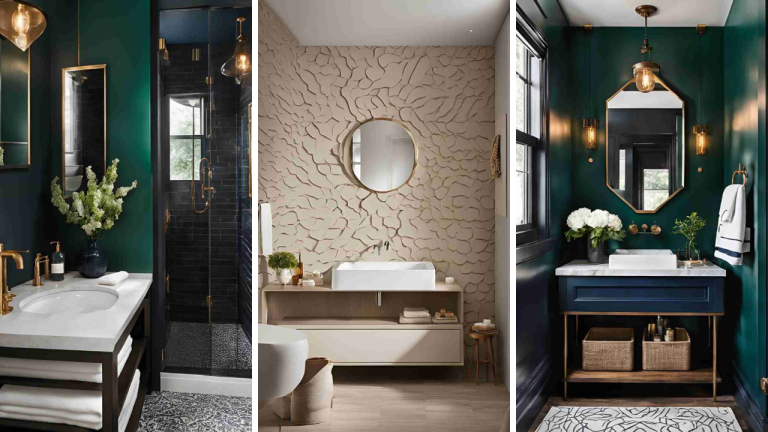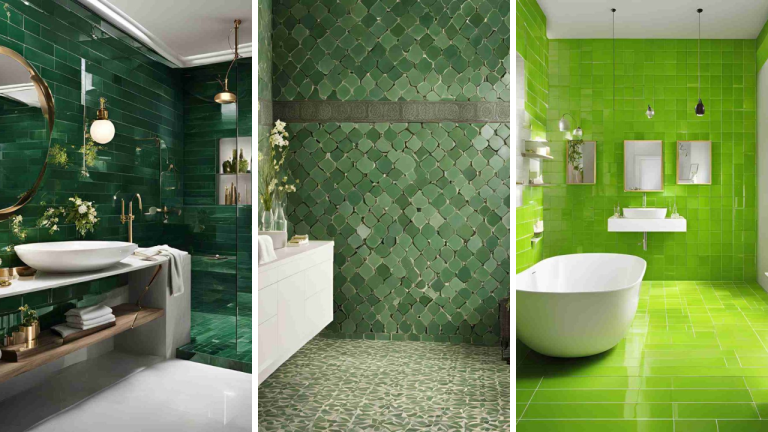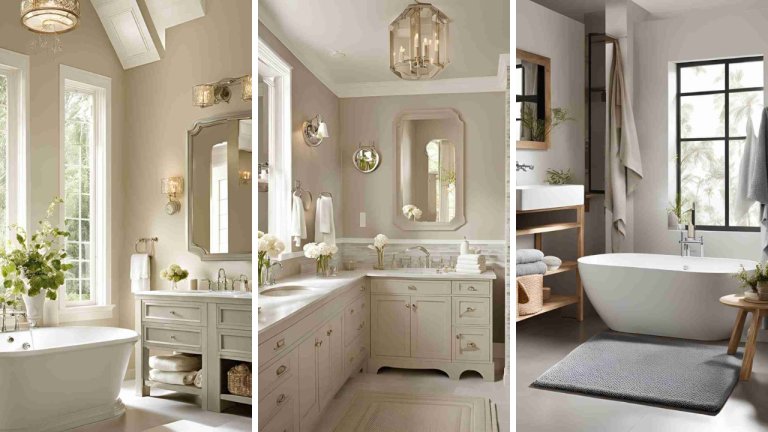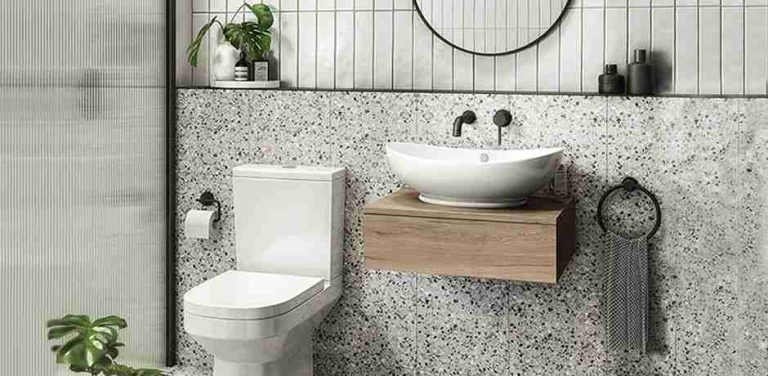Wabi-sabi is all about celebrating the beauty of imperfection and simplicity, and your bathroom can be a perfect canvas for this aesthetic. Here are 21 ideas to inspire a relaxed, naturally beautiful space that showcases uniqueness and organic charm. Whether you’re looking to add some rustic flair or soften your space with natural materials, these tips will help you create a soothing retreat that reflects your personal style.
Earthy Color Palettes for Serenity

When it comes to creating a calming bathroom space, earthy color palettes are a fantastic choice. The image showcases a serene bathroom with muted tones that evoke a sense of tranquility. The soft greys and browns in the tiles and wooden accents create a warm and inviting atmosphere.
The use of natural materials, like the wooden barrels, adds a rustic charm. These elements not only enhance the aesthetic but also bring a touch of nature indoors. The combination of textures, from the smooth tiles to the soft rug, invites relaxation and comfort.
Lighting plays a key role in this design. The warm glow from the ceiling lights highlights the earthy tones, making the space feel cozy. This bathroom is a perfect example of how simple design choices can lead to a peaceful retreat at home.
Natural Light and Open Spaces
Natural light can make a huge difference in a bathroom. This image shows a bright, airy space filled with sunlight. The large window allows light to flood in, creating a warm and inviting atmosphere.
The open layout adds to the feeling of spaciousness. You can see how the design keeps things simple yet stylish. The light-colored tiles and soft textures enhance the calming vibe, making it a perfect spot for relaxation.
Incorporating plants or natural elements, like the vase of dried flowers, brings a touch of nature indoors. This not only adds beauty but also aligns with the wabi-sabi philosophy of appreciating simplicity and imperfection.
Overall, this bathroom is a great example of how natural light and open spaces can transform a functional area into a serene retreat.
Embracing Imperfection with Rustic Elements
Rustic elements bring a warm, inviting feel to any bathroom. In the image, we see a beautiful blend of natural materials and simple design. The wooden walls and countertop create a cozy atmosphere, showcasing the beauty of imperfection.
The round mirror adds a touch of modernity while still fitting into the rustic theme. It reflects the soft light, enhancing the overall warmth of the space. The use of earthy tones in the decor, like the wooden stools and the vase with dried flowers, adds character and charm.
Every piece in this bathroom tells a story. The natural wood grain, the soft textures of the towels, and the minimalist design all contribute to a serene environment. This space encourages relaxation and mindfulness, making it a perfect retreat.
Incorporating rustic elements allows you to embrace the beauty of imperfection. It’s about finding joy in the unique details that make your bathroom feel like home. Consider adding similar elements to your own space for a touch of wabi-sabi style.
Natural Stone Accents in Modern Design
Natural stone accents can bring a unique charm to modern bathrooms. The image showcases a beautifully designed space that highlights this idea perfectly. The warm tones of the stone walls create a soothing backdrop, making the bathroom feel inviting and serene.
The freestanding tub is a standout feature, offering a modern shape that contrasts nicely with the earthy textures of the stone. This combination adds depth and character to the room. The minimalist sink and fixtures in dark tones provide a sleek look, balancing the natural elements with contemporary design.
Lighting plays a key role here, with soft illumination enhancing the stone’s natural beauty. This thoughtful approach to design emphasizes the wabi-sabi philosophy, celebrating imperfections and the beauty of nature. Incorporating natural stone accents can transform a bathroom into a peaceful retreat, perfect for relaxation.
Organic Shapes and Soft Lines
In a wabi-sabi bathroom, organic shapes and soft lines create a calming atmosphere. The image showcases a serene space with rounded fixtures that invite relaxation. The gentle curves of the bathtub and sink contrast beautifully with the sleek lines of the walls, enhancing the overall flow of the room.
The use of natural materials adds warmth to the design. The textured wall tiles mimic the look of stone, providing a tactile element that feels inviting. This blend of shapes and textures encourages a sense of harmony, making the bathroom a perfect retreat.
Soft lighting plays a key role in this design. The warm glow from the fixtures highlights the organic forms, creating a cozy vibe. Mirrors with rounded edges reflect light, further enhancing the soft lines throughout the space.
Overall, this bathroom embodies the essence of wabi-sabi by celebrating simplicity and natural beauty. It’s a reminder that imperfections can bring charm and character to our living spaces.
Minimalist Decor with Personal Touches
This bathroom beautifully captures the essence of minimalist decor while adding personal touches that make it feel inviting. The soft gray walls create a calming backdrop, allowing the simple yet elegant features to shine.
The freestanding tub is a standout piece, offering a modern touch that invites relaxation. A warm yellow towel draped over the edge adds a pop of color, making the space feel cozy and lived-in.
Natural materials play a key role here. The woven rug and the wooden stool bring warmth and texture, contrasting nicely with the sleek surfaces. A round mirror and pendant light above the sink add a stylish flair without overwhelming the simplicity of the design.
Overall, this bathroom is a perfect example of how minimalist decor can be both functional and personal. It encourages a serene atmosphere while reflecting the owner’s taste through thoughtful details.
Incorporating Vintage Finds
When it comes to creating a wabi-sabi bathroom, vintage finds can add a unique charm. The image shows a cozy bathroom filled with various vintage items that tell a story. From the rustic shelves to the eclectic decor, every piece contributes to a warm, inviting atmosphere.
Notice the soft colors and natural materials used throughout the space. The wooden accents and vintage jars bring a sense of history, making the bathroom feel lived-in and loved. Items like old bottles and framed pictures can serve as conversation starters, adding personality to the room.
Don’t shy away from mixing different styles. The combination of a classic bathtub with modern fixtures creates an interesting contrast. This blend of old and new is a hallmark of wabi-sabi design, celebrating imperfections and the beauty of aging.
Incorporating plants, like the flowers in the vase, adds a touch of nature. They not only enhance the aesthetic but also bring life into the space. Vintage finds, when paired with greenery, create a serene environment perfect for relaxation.
Overall, using vintage items in your bathroom can transform it into a cozy retreat. Each piece contributes to a story, making your space feel more personal and inviting.
Textured Materials for Depth
In a wabi-sabi bathroom, textured materials play a key role in creating depth and interest. The image showcases a beautifully designed space that embraces this philosophy. The gray walls, made of stone or concrete, provide a neutral backdrop that highlights the natural elements.
The wooden accents, like the table and the curved ceiling, add warmth and contrast. This balance between cool and warm tones is essential in wabi-sabi design. The round basin on the table is a focal point, drawing the eye with its organic shape and texture.
Natural materials like wood and stone not only enhance the aesthetic but also bring a sense of tranquility. The use of simple, handcrafted elements, such as the stools and the woven rug, emphasizes the beauty of imperfection. Each piece tells a story, making the space feel inviting and lived-in.
Incorporating these textured materials can transform any bathroom into a serene retreat. Whether you choose rough stone, smooth wood, or woven textiles, each element contributes to the overall harmony of the space.
Balancing Functionality with Aesthetic Appeal
The image showcases a stunning bathroom that perfectly embodies the wabi-sabi philosophy. This design embraces simplicity and natural beauty, creating a space that feels both functional and serene.
The use of earthy tones and textures is key here. The stone walls and wooden ceiling bring warmth, while the clean lines of the fixtures maintain a modern touch. The round mirror adds a soft element, reflecting light and enhancing the overall atmosphere.
Functionality is not sacrificed in this design. The layout is practical, with essential fixtures easily accessible. The minimalist approach ensures that every item has a purpose, reducing clutter and promoting a calming environment.
Incorporating wabi-sabi elements into your bathroom can transform it into a peaceful retreat. Focus on natural materials, simple forms, and a cohesive color palette to achieve this balance of beauty and utility.
Integrating Nature with Indoor Plants
Bringing nature indoors can transform your bathroom into a calming retreat. The image showcases a beautiful bathroom filled with various indoor plants, creating a serene atmosphere. The combination of greenery and natural materials adds a touch of wabi-sabi charm.
Notice how the plants are arranged around the bathtub, enhancing the space without overwhelming it. Hanging plants add height and interest, while potted plants on the floor create a lush, inviting feel. This setup encourages relaxation and a connection to nature.
Choosing low-maintenance plants like snake plants and pothos is a great way to start. They thrive in humidity, making them perfect for bathrooms. Adding these elements not only beautifies the space but also improves air quality, contributing to a healthier environment.
Creating a Relaxing Atmosphere with Water Features

Water features can truly transform a bathroom into a serene retreat. The image shows a beautifully designed space that highlights the calming effects of water. A simple yet elegant stone fountain sits beside a wooden table, creating a focal point that draws the eye.
The gentle sound of flowing water adds a soothing element to the room. This can help wash away stress and create a peaceful environment. The use of natural materials, like stone and wood, enhances the wabi-sabi aesthetic, celebrating imperfections and the beauty of nature.
Incorporating plants, like the slender branch in the pot, brings a touch of life and freshness. These elements work together to create a space that invites relaxation and mindfulness. Imagine unwinding in such a bathroom after a long day, surrounded by the gentle sounds and sights of water.
Artful Arrangements of Everyday Items
In a wabi-sabi bathroom, even the simplest items can become artful arrangements. This image showcases a charming setup that highlights the beauty of everyday objects. The use of natural materials, like wood and ceramic, adds warmth and character to the space.
The toilet area is cleverly designed with a wooden shelf that holds various bottles and a small plant. This not only keeps things organized but also brings a touch of nature indoors. The wall art, featuring simple lines, complements the rustic feel, making the space feel inviting.
Notice how the light fixture adds a modern touch while still fitting the overall aesthetic. The combination of textures, from the woven basket to the smooth tiles, creates a balanced look. Each element is thoughtfully placed, showing that even a small bathroom can reflect a unique style.
Soft Textiles and Natural Fabrics
Soft textiles and natural fabrics play a key role in creating a wabi-sabi bathroom. The image showcases a serene space filled with earthy tones and organic materials. Notice how the woven elements, like the rug and poufs, add warmth and texture to the room.
The use of natural fibers, such as cotton and jute, enhances the overall aesthetic. These materials not only feel good but also bring a sense of calm. The towels and accessories in soft hues complement the minimalist design, making the bathroom feel inviting.
Incorporating soft textiles can transform your bathroom into a cozy retreat. Think about adding a plush bath mat or some beautifully draped towels. These small touches can make a big difference in how the space feels.
Overall, the combination of soft textiles and natural fabrics creates a balanced environment. It’s all about finding that perfect mix that resonates with the wabi-sabi philosophy of beauty in imperfection.
Sustainable Practices in Bathroom Design
The bathroom in the image reflects a beautiful blend of wabi-sabi principles and sustainable design. The use of natural materials, like the earthy tones of the pottery and the greenery, creates a calming atmosphere. This approach not only enhances aesthetics but also promotes eco-friendliness.
Incorporating plants, like the hanging vine and potted fern, adds life to the space while improving air quality. Choosing fixtures that conserve water, such as low-flow toilets and faucets, is another way to embrace sustainability. The gray tiles are not just stylish; they can be made from recycled materials, reducing waste.
Lighting plays a key role too. The large window allows natural light to flood the room, minimizing the need for artificial lighting during the day. This connection to nature is essential in wabi-sabi design, reminding us to appreciate the beauty in simplicity and imperfection.
Handcrafted Elements for Authenticity
In a wabi-sabi bathroom, handcrafted elements add a unique touch that celebrates imperfections. This image showcases a beautiful blend of natural materials and simple designs, creating a space that feels warm and inviting.
The round mirror and the pendant light above the sink are perfect examples of how handcrafted items can enhance the overall aesthetic. They bring character and a personal feel to the room. The earthy tones of the tiles and the wooden shelf complement the handcrafted pottery, making the space feel cohesive.
Plants also play a vital role in this design. The greenery adds life and freshness, reminding us of nature’s beauty. A simple woven basket holds towels, adding texture and warmth to the bathroom.
Incorporating these handcrafted elements not only elevates the design but also tells a story. Each piece reflects a commitment to authenticity, making the bathroom a true sanctuary.
